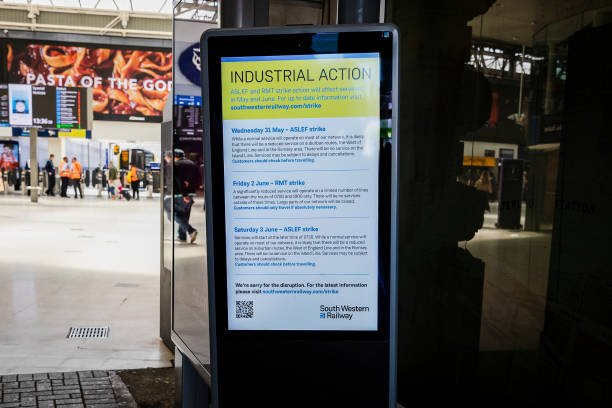Business
Train Strikes: Unveiling the Timing and Motive Behind Them

The train drivers’ union, Aslef, has recently communicated their decision to implement a third ban on working overtime, which may potentially result in some additional disruptions on the railways.
Drivers may choose not to work overtime for a period of six days starting from Monday, July 31st.
The union has initiated its second overtime ban in three weeks, citing concerns regarding pay, jobs, and conditions.
Additionally, it has been brought to attention that members of the RMT union have planned to engage in industrial action on both Thursday and Saturday of this week. Passengers are kindly reminded to check the status of services prior to their travel.
Next Industrial Action: When Will It Occur?
The members of the Associated Society of Locomotive Engineers and Firemen (ASLEF) are engaging in industrial action, specifically implementing an overtime ban, as a means of protest.
The majority of railway companies depend on drivers engaging in overtime work in order to fulfil their complete operational timetables.
The provision of services at fifteen companies headquartered in England will experience disruptions commencing on Monday, July 17th and concluding on Saturday, July 22nd. Subsequently, there will be another period of service interruptions from Monday, July 31st to Saturday, August 5th.
Several train operators are expected to decrease their service levels.
Upcoming Strikes: Dates and Affected Lines
Strikes will be held on Thursday 20, Saturday 22 and Saturday 29 July.
Members of the RMT union will be taking action at 14 rail companies:
- Avanti West Coast
- C2C
- Chiltern Railways
- CrossCountry
- East Midlands Railway
- GTR
- Great Western Railway
- Greater Anglia
- LNER
- Northern Trains
- Southeastern
- South Western Railway
- TransPennine Express
- West Midlands Trains
GTR operates Southern, Thameslink, Great Northern and Gatwick Express.
Greater Anglia includes Stansted Express.
Trains Running on Strike Days: Will Some Still Operate?
According to the Rail, Maritime and Transport (RMT) union, a total of 20,000 individuals affiliated with the union, encompassing guards, train managers, and station staff, are expected to engage in a strike action.
During previous instances of strike action, a significant number of cancellations were observed, resulting in the complete suspension of operations on certain lines.
In areas where services have been provided, there has been a tendency for them to commence at a later time and conclude earlier than the standard schedule.
It is recommended that passengers verify with the operator prior to embarking on their journey.
The Strike of Railway Workers: What’s the Reason Behind It?
According to labour unions, it is imperative that any remuneration proposal takes into account the escalating cost of living, particularly in light of the fact that the inflation rate has only recently fallen below the threshold of 10%.
However, the railway sector is currently facing financial constraints due to the impact of the pandemic, necessitating cost-saving measures.
Employers assert that in order to facilitate salary increments and modernise the railway system, it is imperative to reach a consensus on implementing reforms.
Rail Workers’ Pay: How Much Do They Earn?
According to the Office for National Statistics (ONS), the mean annual income of railway employees in 2022 amounted to £45,919.
If drivers are not considered, as they are typically affiliated with the Aslef union rather than the RMT, the estimated amount is £39,518. Nevertheless, the RMT union has expressed its contention that the aforementioned figure is excessively inflated, primarily due to the omission of rail cleaning personnel from the calculation.
According to the Office for National Statistics (ONS), the median salary for individuals employed as “train and tram drivers” amounts to slightly less than £59,000.
According to Mick Whelan, the general secretary of the Aslef union, train drivers have not experienced any salary increases for a period of four years, despite typically receiving higher compensation compared to other employees in the rail industry. This statement was made during an interview with BBC News on May 12th. He was specifically alluding to individuals who are engaging in industrial action.
The absence of a newly negotiated compensation arrangement can be attributed to the expiration of their previous agreement in 2019.
Nevertheless, according to Transport Minister Huw Merriman, the remuneration of train drivers has experienced a substantial surge of 39% since 2011, thereby constituting the most significant increment among all occupational cohorts.
The assertion regarding the 39% increase is accurate; however, it remains undetermined whether this represents the most substantial increase among all employment cohorts. This phenomenon can be attributed to alterations in the manner in which the data has been disseminated in the past decade.
The Offer Extended to Rail Workers: What’s on the Table?
The Rail Delivery Group (RDG), an organisation that serves as a representative body for the 14 train companies, proposed a remuneration package that entailed a retroactive salary increase of 5% for rail employees in the year 2022. Subsequently, it would engage in negotiations regarding reforms in anticipation of a subsequent annual salary increase with each individual operator.
On the 5th of May, members of the RMT voted in favour of extending the strike mandate for an additional duration of six months.
In contrast, the Aslef union has declined a two-year proposal entailing a retroactive salary increment of 4% for the year 2022, along with a 4% augmentation for the current year.
On the 20th of March, RMT members accepted a revised offer from Network Rail, thereby resolving the aforementioned dispute.
According to the union, the proposal represents a salary increase ranging from 14.4% for the lowest paid grades to 9.2% for the highest paid individuals.











